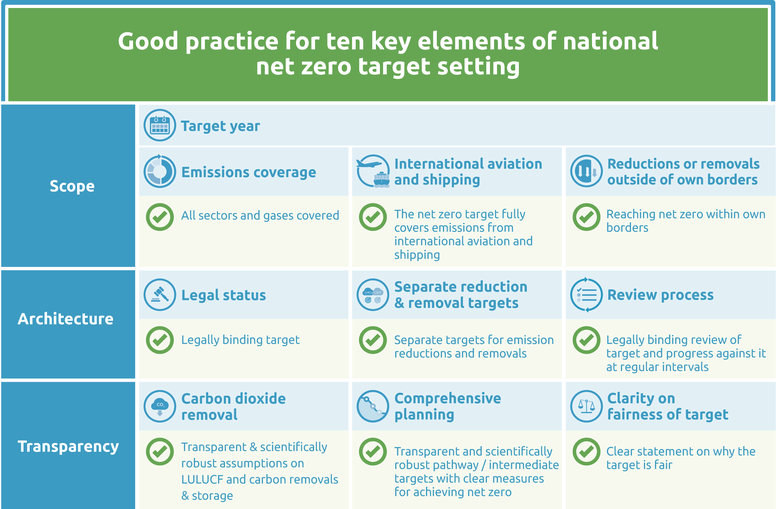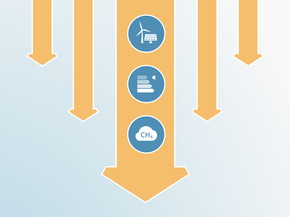Net zero targets
Summary
We evaluate the net zero target as: Average
In January 2024, just weeks after COP28, the UAE submitted its first long-term strategy (LTS) to the UNFCCC, including its 2050 net zero target (Government of the UAE, 2024). The LTS officially communicates longer-term targets beyond 2030. In 2021 the UAE had already announced its intention to reach net zero by 2050, as part of the UAE Net Zero 2050 Strategic Initiative.
The LTS significantly improves the clarity of the UAE’s net-zero target and covers most key elements considered important by the CAT to enhance transparency, target architecture, and scope. For example, the government has enshrined the target into law, provides a transparent assumption on the use of carbon dioxide removal in the target year, and establishes a legally-binding review process of the target in five-year intervals. We evaluate the comprehensiveness of the UAE’s net zero target as ‘average’, an upgrade from the ‘poor’ rating ahead of the LTS submission.
Despite this progress, the UAE has several avenues to improve the scope, target architecture and transparency of its net zero target. For example, the government could include F-gases, international aviation, and international shipping under its target coverage, or explain why its net zero target is a fair contribution to the global goal of limiting warming to 1.5˚C above pre-industrial levels, and transparently address any existing gap between its net zero target and what would be a fair target.
Additionally, it is concerning that the UAE's plans to increase use of fossil gas to meet its net zero target, and also has a heavy reliance on carbon capture and storage (CCS), a technology that is neither commercially viable, nor one that reduces emissions to zero (Climate Action Tracker, 2023a). The UAE’s major oil and gas expansion plans are clearly not in line with a global transition to net zero emissions. According to the IEA (2023), there should be no new investments into oil and gas projects under a net zero scenario.
Ten key elements
Scope
- Target year – The UAE aims to reach net zero by 2050.
- Emissions coverage – The UAE specifies that the target covers CO2, CH4 and N2O across all economic sectors, while explicitly excluding F-gases. The government claims that these gases cover around 95% of all emissions (Government of the UAE, 2024, p. 45). However, according to the latest available historical data (third-party, not nationally reported), F-gas emissions represented 9% of total UAE emissions in 2022 (Gütschow & Pflüger, 2023).
- International aviation and shipping – The target excludes both international aviation and shipping.
- Reductions or removals outside of own borders – While the UAE generally plans to reach net zero through domestic actions and does not intend to use removals outside its own borders, it reserves the rights to use international offset credits “to achieve net zero in adverse local circumstances” (Government of the UAE, 2024, p. 91). The government might further use international offset credits under the Paris Agreement’s Article 6 to go beyond its net zero target (Government of the UAE, 2024, p. 88).
Target architecture
- Legal status – The UAE includes its net zero target in its first long-term strategy (LTS) submitted to the UNFCCC in January 2024. According to the LTS, the cabinet has further enshrined the target into domestic law (Government of the UAE, 2024, p. 90). In March 2023, the United Arab Emirates Cabinet signed the “UAE Governments Net Zero 2050 Charter”.
- Separate reduction & removal targets – The UAE specifies separate emission reduction and removal targets (Government of the UAE, 2024, p. 49).
- Review process – The UAE commits to regularly review and revise its net zero target in a legally binding process (Government of the UAE, 2024, p. 91). It plans updates to its LTS (Government of the UAE, 2024, p. 92).
Transparency
- Carbon dioxide removal – The UAE provides transparent assumptions on its intended use of carbon dioxide removal (CDR). The government intends to reach 3.5 MtCO2e of LULUCF sinks through expanded mangroves (compared to around 1 MtCO2e in 2023) and 9.5 MtCO2e of engineered CDR through direct air capture technologies (Government of the UAE, 2024, p. 88).
- Comprehensive planning – The UAE’s 2023 LTS provides sector-level pathways, emission reduction targets and measures to achieve them (Government of the UAE, 2024, pp. 48–87). The government commits to economy-wide absolute net emissions targets for 2040 (86 MtCO2e) and 2045 (51 MtCO2e).
For the energy sector, the UAE plans on deploying large-scale renewables, nuclear energy, and fossil gas as key pillars to achieving net zero by 2050. The UAE's planned use of fossil gas to meet its net zero target implies a heavy reliance on carbon capture and storage (CCS), a technology that is neither viable, nor one that reduces emissions to zero (Climate Action Tracker, 2023a). More specific planning for the energy mix towards 2040 and 2050 remains a work in progress (Government of the UAE, 2024, p. 50). In previous iterations of its 2050 Energy Strategy, the UAE still foresaw a major role for fossil gas in 2050.
The UAE also foresees a big role for CCS in the industry sector, where it will account for 32% of all emission reductions by 2050 (Government of the UAE, 2024, pp. 58–60), equivalent to around 44 MtCO2e. CCS will be used for heavy industrial processes (steel, cement, aluminium, others), oil and fossil gas processing, and refineries. The government further plans to expand the hydrogen production using fossil gas (so-called ‘blue’ hydrogen) to around 50% of the total hydrogen production by 2040 and 2050.
The UAE states that it intends to further expand its oil and gas production to meet global demand (Government of the UAE, 2024, p. 57), while it refers to the 2045 net zero target by its state-own ADNOC oil and gas company. The latter target, however, only covers operational emissions (scope 1 and 2) while excluding all use-phase emissions of burning the exported oil and gas (ADNOC, 2023). Such "scope 3" emissions account for the majority of ADNOC emissions along its value chain and ought to be covered by corporate net zero targets as mandated by the UN High Level Expert Group (UN HLEG, 2022). - Clarity on fairness of target – The UAE makes no reference to fairness or equity in the context of its net zero target.
Good practice
The Climate Action Tracker has defined the following good practice for all ten key elements of net zero targets. Countries can refer to this good practice to design or enhance their net zero targets.
Further analysis
Latest publications
Stay informed
Subscribe to our newsletter





